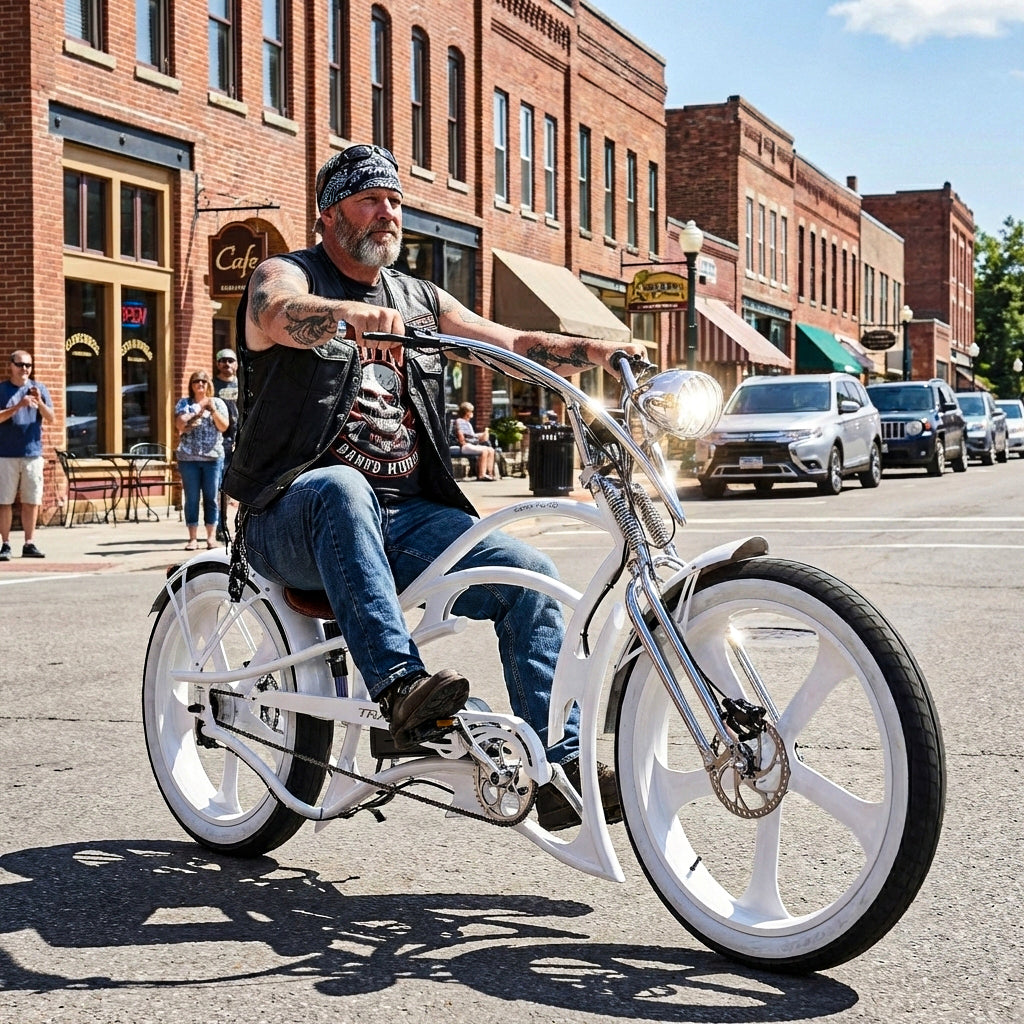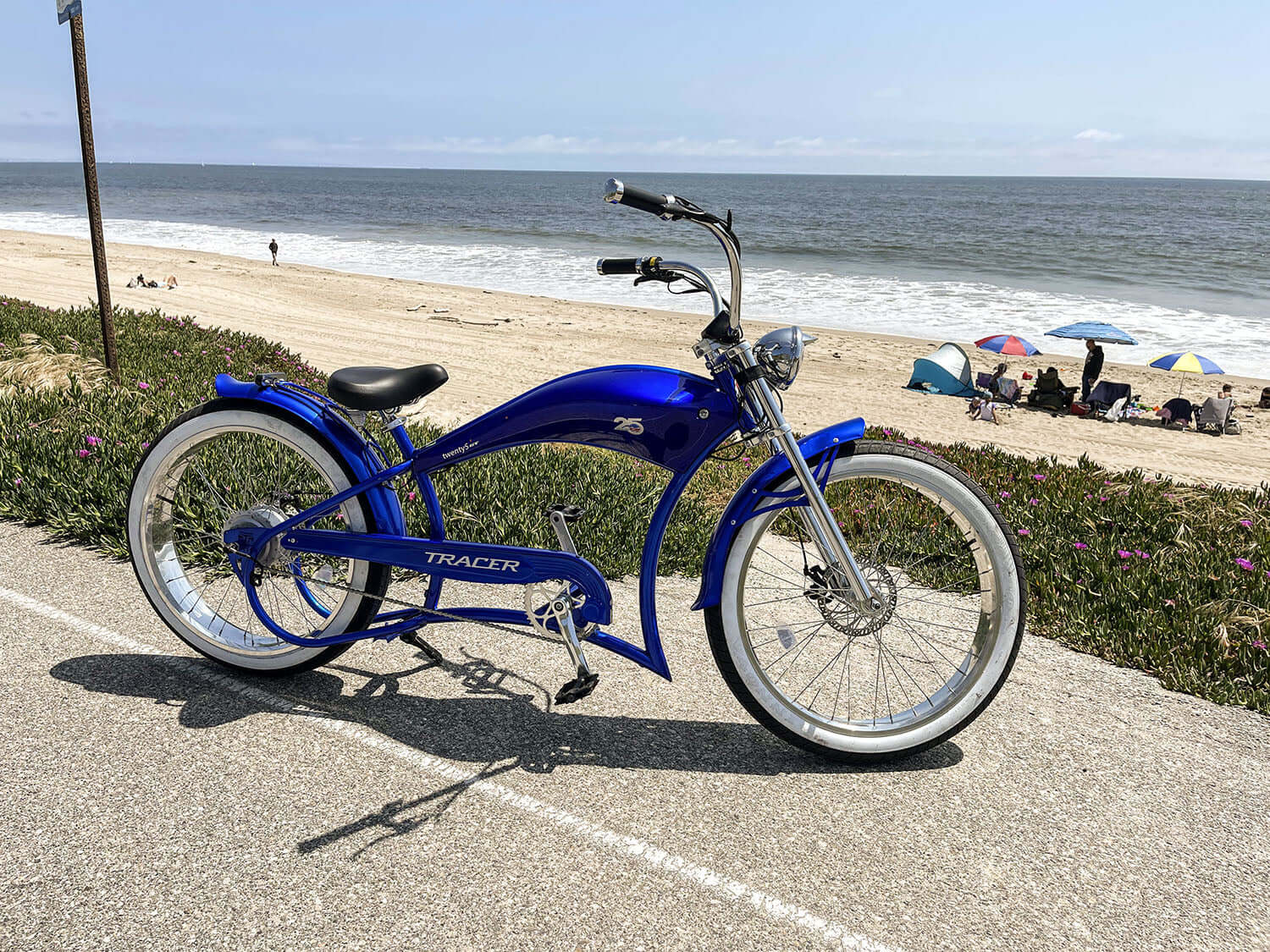Are you in the market for a new bike which could ride in all terrains? there are so many different ways to experience bikes, and so many different types of bikes to choose from. Look no further than the fat-tire bike. In this comprehensive guide, we'll explore the top five reasons why a fat-tire bike should be your next investment. From its unmatched versatility to its ability to provide comfort and stability on any surface, you'll discover why fat-tire biking is a game-changer for cyclists of all levels. there is no wrong way to come to bikes and bike riding and for every person, there is an ideal type or style of bike, and for you, that ideal style might be what is called a "fat-tire bike".
The Origin and Scenario Application of Fat Wheel Bicycles
In the cycling world, fat wheel bikes are gaining popularity. These bicycles are equipped with extra-wide tires, allowing people to conquer various difficult terrains and extreme weather conditions. From snow to beaches, from rugged mountain roads to city streets, fat wheel bikes are favored by more and more cycling enthusiasts for their unique design and functionality.
The concept of fat wheel bikes grew out of the need for extreme terrain challenges. In the 1980s, Alaskan cyclists Steve Baker and Simon Roaker began trying to cross ice, snow and desert terrain. To meet these extreme challenges, they created a unique bike equipped with specially wide tires to increase stability and traction on unstable terrain. Over time, these fat wheel bikes gradually attracted wider attention and were widely used in various application scenarios.
First off, fat wheel bikes are great at off-road riding. Whether it’s rough mountain trails or slippery mud, fat wheel bikes can handle it with ease. Its extra-wide tires provide a larger contact area, increasing stability and traction, allowing riders to traverse a variety of complex terrains.
Secondly, fat wheel bikes excel at snow and beach riding. Traditional bikes tend to get stuck in snow or sand, but fat bikes' extra-wide tires glide easily over these surfaces, giving riders a smooth ride.
Additionally, fat wheel bikes also play an important role in urban cycling. Its comfortable riding position and stable performance make it ideal for urban commuting and casual riding. Whether on busy urban roads or suburban trails, fat bikes adapt to any scenario with ease.
Tracer bikes have a wide range of fat bikes, including e-bikes. chopper bike and chopper ebike
Tracer Stretch Cruiser Bikes most of fat tire bike (3inch -4 inch)
1.Tracer Arcadia GT Chopper Cruiser Bike 1 Speed

This 26-inch Chopper Cruiser Bike boasts a distinctive design with a vintage flair. Its elongated steel frame, coupled with high-rise handlebars, creates a unique appearance reminiscent of chopper motorcycles. The single-speed configuration and KT coaster brake system simplify the bike's structure, offering riders a classic cycling experience. The Triple Tree Fork further enhances the chopper-style aesthetic.
The retro-style high-rise handlebar, measuring 330mm in height and 750mm in width, provides a delightful riding posture for cyclists. The alloy fat polish rim and the 26"x3" wide front tire, crafted with a 36H*13G chrome spoke front wheel, enhance both the bike's visual appeal and riding stability.
2.Tracer Avalon GT 26'' Fat Tire Stretch Beach Cruiser Bike 1-Speed/7-Speed

Designed for leisurely rides
A classic design meets modern comfort. The sturdy Tracer Classic Hi-ten steel frame and Tracer Hi-tensile steel fork provide a robust foundation for your riding adventures. With a Tracer Steel Hi-Rise handlebar offering a comfortable 13-inch rise and a generous 29.5-inch width, this bike ensures an ergonomic and relaxed riding position.
3.Tracer Loiter 26" 48V 800W Cruiser E-Bike

Experience the ultimate in off-road riding with our Fat 26x4.0 tires. These oversized, rugged tires provide superior traction and stability, conquering any terrain with ease. Whether you're navigating sandy shores, snowy landscapes, or challenging trails, these fat tires ensure a smooth and adventurous journey every time.
4.Tracer Twenty5 GTS 500W 26" Cruiser E-Bikes

The 26-Inch Electric Stretch Chopper Bike is a perfect blend of style and performance. Available in four vibrant colors (Black, Blue, Green, and Red), this bike features a sturdy Tracer Stretch Chopper Hi-ten steel frame with a sleek plastic battery tank cover. Equipped with a 500W high-speed brushless motor and a powerful 48V/17.5Ah LG lithium battery, it offers a top speed of 25 mph and a travel range of up to 50 miles on a full charge.
Designed for comfort, this bike boasts a vintage-style leather spring saddle, an alloy crankset, and a hydraulic disc brake system for smooth stops. Its intelligent Pedals Assisted System offers three riding modes and five levels of pedal assist, ensuring a natural and enjoyable riding experience. With its alloy fat tires, LED lights, and front and rear fenders, this electric chopper bike is not just a mode of transport, but a statement on the road. Perfect for long-distance travel, exercise, and everything in between!
Technical Advantages of Fat Tires
Fat wheel bikes are certainly a compelling topic when exploring the frontiers of bicycle technology. Fat wheel bikes excel in various riding environments with their unique design and technical advantages. Let’s take a closer look at the technical advantages of fat wheel bikes, including tire design, materials, and air pressure regulation.
Tire Design: The tire design of a fat wheel bike is one of its most distinguishing features. Typically, these tires are much wider than traditional bicycle tires, usually over3- 4 inches. This wide tire design provides a larger contact patch, increasing traction and stability on a variety of terrains. In addition, fat wheel bike tires typically have deeper treads to provide better grip, allowing riders to safely traverse difficult terrain such as mud, snow, and sand.
Material selection: Fat wheel bike tires are usually made of special rubber materials to ensure their wear resistance and durability in various conditions. These tires are also specially designed to provide optimal shock absorption, allowing riders to enjoy a comfortable ride even on bumpy terrain. In addition to the tires, high-strength materials are used in the frame and other components of a fat wheel bike to ensure its stability and durability.
Air Pressure Regulation: Fat wheel bike tires can handle lower air pressures than traditional bikes. This means the rider can adjust the tire pressure for optimal performance and comfort based on different terrain and riding conditions. Lowering the air pressure can increase the contact area between the tire and the ground, improving traction and stability, especially on complex terrain such as mud, snow and sand.
Health and Environment
Fat tire bicycles are not only a riding tool, but also a powerful tool for promoting health and environmental protection. Let’s dive into the health and environmental benefits of fat biking.
- Physical Health: Riding a fat bike is a challenging and aerobic form of exercise that has significant health benefits. First, riding a fat bike can enhance cardiopulmonary function and endurance, helping to reduce the risk of cardiovascular disease and high blood pressure. Secondly, riding a fat tire bike can also exercise the lower body muscles, including thigh muscles, calf muscles and buttock muscles, and enhance physical strength and body flexibility. In addition, long-term riding of fat tire bikes can also help control weight, promote metabolism, reduce fat accumulation, and improve the overall health of the body.
- Mental Health: Riding a fat bike not only provides physical exercise but also promotes mental health. The beautiful scenery of nature and fresh air make cyclists feel relaxed and happy physically and mentally. Riding a fat bike can also reduce stress and anxiety, improve your mood, and increase your confidence and self-esteem. At the same time, cycling is also a social activity where you can share happy moments with family and friends and enhance mutual affection and communication.
- Environmental protection: Riding a fat bike is an environmentally friendly way of traveling and has a positive impact on the environment. Compared with cars and motorcycles, riding a fat tire bike does not emit harmful gases and tail gases, reducing air pollution and greenhouse gas emissions. Additionally, riding a fat bike reduces the consumption of natural resources such as fuel and energy. By choosing to ride fat bikes, people can contribute to environmental protection and jointly build a clean and beautiful earth home.
Purchase Guide
Buying a fat bike can be an important decision, so providing a detailed buying guide can help readers choose the bike that best suits their needs. Here are some considerations and buying suggestions:
- Determine the purpose: First, consider what the primary purpose of the bike is. Is it for mountain biking, beach biking or daily commuting? Different uses may require different types of fat bikes, such as mountain fat bikes, beach fat bikes, chopper bikes, or commuter fat bikes.
- Choose tire size: Tire sizes for fat bikes are usually 4 inches or more, but there are different sizes available. Larger tire sizes are generally suitable for more challenging riding environments, such as snow or sand, while smaller tire sizes are better suited for daily commuting or casual riding.
- Consider the suspension system: Some fat bikes are equipped with fork suspension systems that provide better shock absorption, especially when riding on uneven terrain. If you regularly ride rough mountain trails, it may be more appropriate to choose a bike with a suspension system.
- Materials and Construction: Considering your bike’s materials and construction is critical to its performance and durability. A lightweight but strong aluminum frame is usually a good choice, but carbon fiber or steel frames are also available, depending on personal preference and budget.
- Test rides: Before buying, it’s a good idea to test ride a few different models of fat bikes to find the style and size that works best for you. A test ride provides a better understanding of the bike's comfort, handling, and performance.
- Know the brand and reviews: When choosing a bike, it’s also important to know the brand’s reputation and user reviews. Choosing fat tire bikes from well-known brands can provide you with better quality and after-sales service guarantees.
- Budget Considerations: Finally, consider your budget and choose a fat bike that fits within your budget. Remember, in addition to the price of the bike itself, there are additional costs such as accessories, maintenance and upkeep to consider.
Maintaining and Servicing Your Fat Bike
Maintaining and servicing your fat bike is the key to ensuring its long-term use and good performance. Here are some tips to help you keep your bike in good shape:
Clean it regularly: Cleaning your bike regularly removes built-up dust, mud, and other impurities and maintains your bike's appearance and performance. Clean the frame, rims, gears and chain using mild soapy water and a soft brush, then rinse with clean water.
Maintain tire pressure: Maintaining proper tire pressure is one of the important factors in ensuring good performance on your fat bike. Check your tire pressure regularly and inflate or deflate as needed to ensure your tires stay within the recommended pressure range.
Lubricate the chain: Lubrication of the chain is essential for a smooth ride. Lubricate the chain regularly using an appropriate bicycle chain lubricant and use a clean cloth or brush to remove excess lubricant.
Regularly check and adjust components: Regularly check various components of your bike, including brakes, derailleurs, screws and nuts, etc., and make sure they are in good working order. Make adjustments or replace worn parts as needed.
Store in a dry and ventilated place: When the bike is not in use, store it in a dry and ventilated place to avoid exposure to moisture and extreme temperatures. Use a bike cover to protect your bike from dust and sunlight.
Check wheels and bearings regularly: Wheel hubs and bearings are one of the key parts of your bike, check them regularly and make sure they are in good condition. Clean hubs and bearings and add lubricant as needed to reduce friction and wear.
Pay attention to safety: When riding, pay attention to safety, including wearing a helmet, using front and rear lights and reflective equipment, and obeying traffic rules and riding etiquette.
-
Who are fat tire bikes suitable for?
- Fat tire bikes are suitable for various types of riders, including mountain biking enthusiasts, adventure seekers, urban commuters, and those seeking novelty and challenge in cycling. They are versatile and adaptable to various terrains and riding conditions.
-
How do fat tire bikes differ from regular bikes?
- The main difference between fat tire bikes and regular bikes lies in their wide tires. These tires are typically much wider than those of regular bikes, providing better flotation and stability to adapt to various complex terrains.
-
What terrains are fat tire bikes suitable for riding on?
- Fat tire bikes are suitable for riding on a variety of terrains, including beaches, snow-covered trails, muddy mountains, gravel paths, and more. Their wide tires and superior flotation allow them to easily handle various complex terrains.
-
How do you adjust the tire pressure of fat tire bikes?
- The tire pressure of fat tire bikes can be adjusted according to riding conditions. Generally, lower pressure is suitable for riding on soft terrains such as sand and mud, while higher pressure is suitable for riding on hard surfaces and roads.
-
What maintenance and care do fat tire bikes require?
- Maintenance and care for fat tire bikes are similar to regular bikes and include regular cleaning, maintaining tire pressure, lubricating the chain, inspecting and adjusting components, etc. Regular maintenance and care ensure the bike remains in good condition for long-term use.
-
Are fat tire bikes suitable for long-distance riding?
- Yes, fat tire bikes are very suitable for long-distance riding. Their comfort and stability make them an ideal choice for long-distance rides, whether on mountain trails, beaches, or roads, providing a great riding experience.





Leave a comment
This site is protected by hCaptcha and the hCaptcha Privacy Policy and Terms of Service apply.